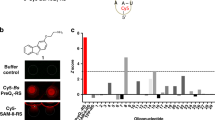Abstract
RNA–protein interactions play important roles in gene regulation, functional RNA–protein complexes such as the ribosome, and in viral replication. Molecules that regulate specific RNA–protein interactions may be used to dissect biological processes, and to establish the validity of targeting an RNA–protein interaction. There are many examples of biological regulation by antisense RNA stem-loops that form loop-loop and loop-linear RNA–RNA interactions. Here, a bacterial reporter system for the identification of RNA stem-loops that inhibit the formation of RNA–protein complexes through RNA–RNA interactions is described.
Access this chapter
Tax calculation will be finalised at checkout
Purchases are for personal use only
Similar content being viewed by others
References
Vickers TA, Wyatt JR, Freier SM (2000) Effects of RNA secondary structure on cellular antisense activity. Nucleic Acids Res 28:1340–1347
Vickers TA et al (2003) Efficient reduction of target RNAs by small interfering RNA and RNase H-dependent antisense agents. A comparative analysis. J Biol Chem 278:7108–7118
Eguchi Y, Itoh T, Tomizawa J (1991) Antisense RNA. Annu Rev Biochem 60:631–652
Wagner EG, Simons RW (1994) Antisense RNA control in bacteria, phages, and plasmids. Annu Rev Microbiol 48:713–742
Brunel C, Marquet R, Romby P, Ehresmann C (2002) RNA loop-loop interactions as dynamic functional motifs. Biochimie 84:925–944
Tinoco I Jr, Bustamante C (1999) How RNA folds. J Mol Biol 293:271–281
Franklin NC (1993) Clustered arginine residues of bacteriophage lambda N protein are essential to antitermination of transcription, but their locale cannot compensate for boxB loop defects. J Mol Biol 231:343–360
Harada K, Martin SS, Frankel AD (1996) Selection of RNA-binding peptides in vivo. Nature 380:175–179
Hall KB (1994) Interaction of RNA hairpins with the human U1A N-terminal RNA binding domain. Biochemistry 33:10076–10088
Yano A et al (2010) Identification of antisense RNA stem-loops that inhibit RNA–protein interactions using a bacterial reporter system. Nucleic Acids Res 38:3489–3501
Harada K, Frankel AD (1999) Screening RNA-binding libraries using a bacterial transcription antitermination assay. In: Haynes SR (ed) RNA-protein interactions protocols, methods in molecular biology, vol 118. Humana, New York, pp 177–187
Horiya S et al (2009) Replacement of the λ boxB RNA-N peptide with heterologous RNA-peptide interactions relaxes the strict spatial requirements for the formation of a transcription antitermination complex. Mol Microbiol 74:85–97
Eguchi Y, Tomizawa J (1991) Complexes formed by complementary RNA stem-loops. Their formations, structures and interaction with ColE1 Rom protein. J Mol Biol 220:831–842
Duconge F, Di Primo C, Toulme JJ (2000) Is a closing "GA pair" a rule for stable loop-loop RNA complexes? J Biol Chem 275:21287–21294
Jossinet F et al (1999) Dimerization of HIV-1 genomic RNA of subtypes A and B: RNA loop structure and magnesium binding. RNA 5:1222–1234
Dardel F et al (1998) Solution studies of the dimerization initiation site of HIV-1 genomic RNA. Nucleic Acids Res 26:3567–3571
Mujeeb A et al (1998) Structure of the dimer initiation complex of HIV-1 genomic RNA. Nat Struct Biol 5:432–436
Ennifar E et al (2001) Crystal structures of coaxially stacked kissing complexes of the HIV-1 RNA dimerization initiation site. Nat Struct Biol 8:1064–1068
Author information
Authors and Affiliations
Corresponding author
Editor information
Editors and Affiliations
Rights and permissions
Copyright information
© 2015 Springer Science+Business Media New York
About this protocol
Cite this protocol
Harada, K. (2015). Identification of Antisense RNA Stem-Loops That Inhibit RNA–Protein Interactions Using a Bacterial Reporter System. In: Schmidt, F. (eds) RNA-RNA Interactions. Methods in Molecular Biology, vol 1240. Humana Press, New York, NY. https://doi.org/10.1007/978-1-4939-1896-6_4
Download citation
DOI: https://doi.org/10.1007/978-1-4939-1896-6_4
Published:
Publisher Name: Humana Press, New York, NY
Print ISBN: 978-1-4939-1895-9
Online ISBN: 978-1-4939-1896-6
eBook Packages: Springer Protocols




